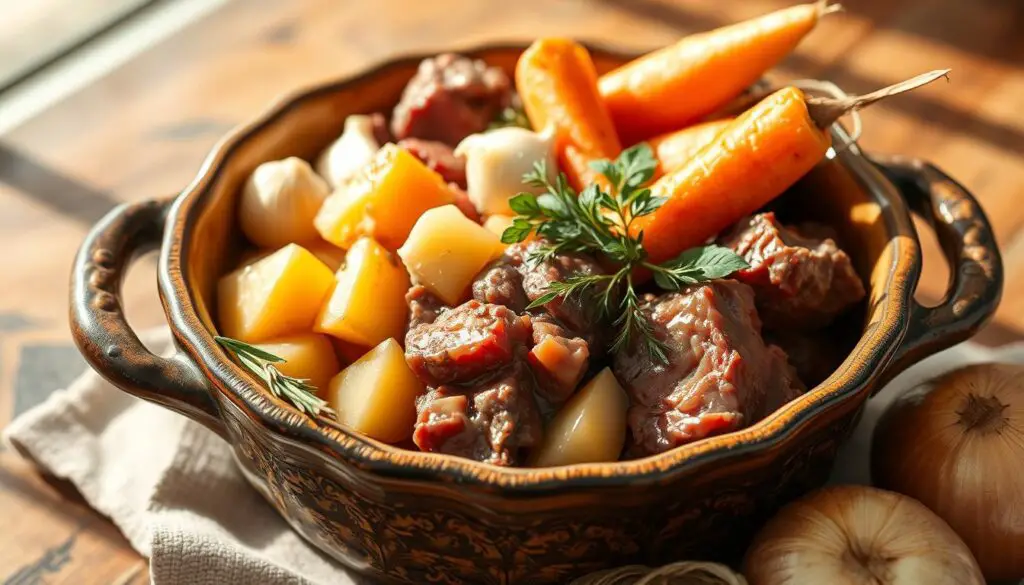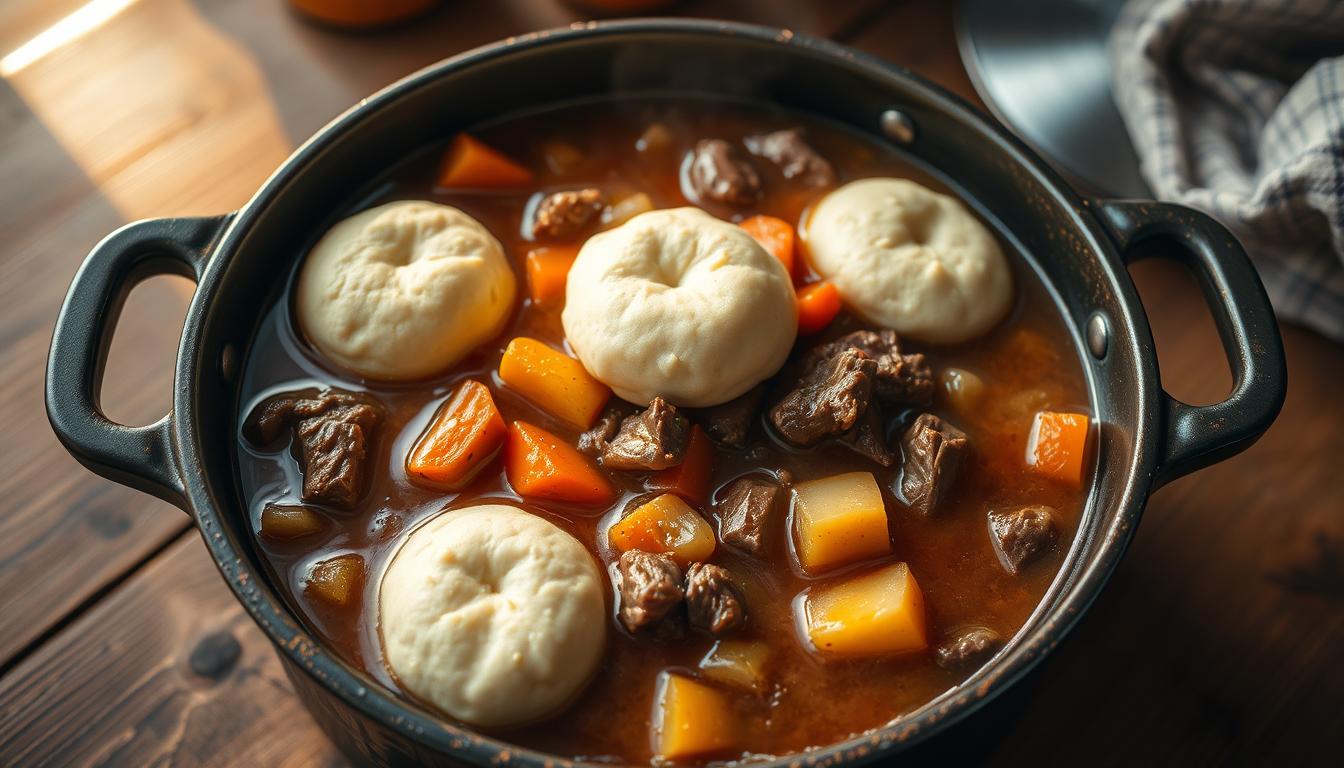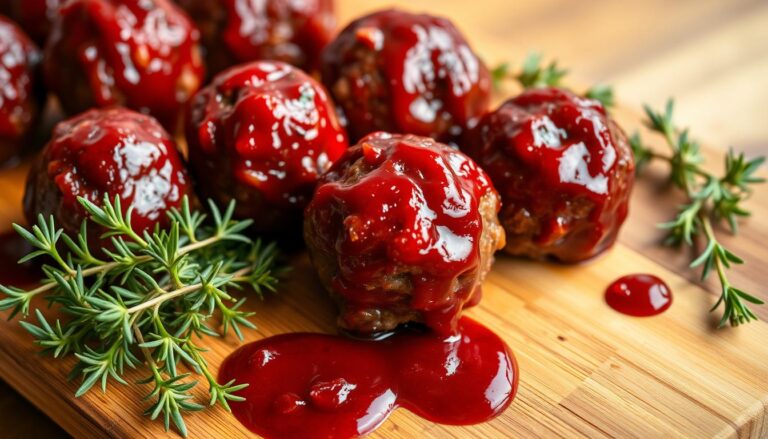As the weather cools down, there’s nothing like a warm, comforting bowl of Classic Slow Cooker Beef Stew to satisfy your hunger. I’ve spent years perfecting my slow cooker recipe, and I’m excited to share it with you.
This traditional dish is loaded with tender chunks of beef, golden potatoes, carrots, and peas in a rich, flavorful broth. The slow cooker method ensures the meat becomes incredibly tender while the flavors meld beautifully.
Perfect for busy weeknights or weekend family dinners, this stew can be prepared ahead of time, making it a convenient and delicious meal option.
Key Takeaways
- A hearty, comforting meal perfect for cold weather
- Tender beef and vegetables in a rich, flavorful broth
- Easy to prepare ahead of time for busy days
- Slow cooker method ensures tender meat and blended flavors
- A traditional recipe with a personal touch
The Perfect Comfort Food for Cold Weather
As the temperature drops, a warm bowl of beef stew becomes the ultimate comfort food. I’ve found that slow cooker beef stew is a staple during cold weather months, providing warmth and satisfaction in every bite.
Why Slow Cooker Beef Stew is a Family Favorite
The slow cooking process allows the flavors to develop deeply, creating a rich and hearty dinner that’s perfect for family gatherings. Families love this recipe because it’s both nutritious and delicious, combining beef, vegetables, and complex flavor profiles in one dish.
What Makes This Recipe Special
 stew special is the perfect balance of ingredients – no single component overpowers the others. The convenience of using a slow cooker makes this recipe appealing for busy families who still want a home-cooked meal.
stew special is the perfect balance of ingredients – no single component overpowers the others. The convenience of using a slow cooker makes this recipe appealing for busy families who still want a home-cooked meal.
Choosing the Best Ingredients
When it comes to crafting the perfect slow cooker beef stew, ingredient selection is key. The quality of the ingredients significantly impacts the final taste of your beef stew.
Best Cuts of Beef for Slow Cooker Stew
For the best results, I recommend using chuck roast as your beef cut of choice due to its connective tissue that breaks down during slow cooking, resulting in tender meat. It’s also a more affordable option than other cuts, making it practical for family meals. Alternative beef cuts that work well include rump roasts and bottom rounds.
Selecting the Right Potatoes and Vegetables
When it comes to potatoes, I’ve found that Yukon Gold or Red potatoes are superior for stew because they maintain their shape during long cooking times. For vegetables, choose firm carrots, onions with tight layers, and fresh garlic for the best flavor foundation.
- Yukon Gold potatoes hold up well due to their lower starch content.
- Firm carrots and fresh garlic enhance the overall flavor.

Essential Ingredients for Classic Slow Cooker Beef Stew
The key to a mouth-watering slow cooker beef stew is choosing the right ingredients. A well-balanced stew requires a mix of protein, vegetables, and flavorful liquids.
Meat and Vegetables
For the meat component, you’ll need approximately 2½ pounds of beef chuck roast cut into 1-inch cubes. The vegetable foundation consists of diced yellow onions, minced garlic, chunky carrots, and baby Yukon gold potatoes. I also include frozen peas added near the end of cooking to maintain their bright color and texture.
- Beef provides the hearty protein base.
- Onions and garlic add depth to the stew.
- Carrots and potatoes add substance and nutrition.
Liquids and Seasonings
For the liquid base, I use a combination of beef broth and red wine (typically cabernet sauvignon or merlot) that creates depth of flavor. The seasonings include a blend of garlic salt, celery salt, black pepper, Worcestershire sauce, and tomato paste for a rich umami profile. Bay leaves and fresh rosemary sprigs infuse the stew with aromatic herbs.
Preparation Tips Before Slow Cooking
To achieve a truly exceptional beef stew, it’s essential to get the preparation right. Proper preparation before slow cooking is crucial for developing the rich flavors that make beef stew so delicious.
Properly Cutting and Seasoning the Beef
When cutting the beef, I aim for consistent 1-inch cubes and remove any large pieces of fat while keeping the marbled fat that adds flavor. Seasoning the beef thoroughly with pepper, garlic salt, and celery salt ensures the flavor penetrates throughout the meat.
The Importance of Searing the Meat
Searing the meat in batches for 45 seconds per side in a hot skillet creates a nice color, flavor, and texture for the stew. This step also creates a nice base to soften up the onions and garlic, ultimately enhancing the overall flavor of the dish.
Step-by-Step Cooking Instructions
Let’s dive into the step-by-step guide on how to cook a classic beef stew to perfection in a slow cooker. This process involves preparing the beef, adding vegetables and liquids, and slow cooking to achieve tender results.
Preparing the Beef
First, I season the beef cubes with a mixture of pepper, garlic salt, and celery salt, then toss them in flour to create a light coating. The seasoned beef should be seared in batches in a hot skillet with olive oil for about 45 seconds per side before transferring to the slow cooker.
Adding Vegetables and Liquids
Next, I use the same skillet to soften diced onions and minced garlic, scraping up the flavorful browned bits from the meat. Then, I add beef broth, wine, and other ingredients to the cooker, excluding peas, cornstarch, and finishing butter.
Slow Cooking Times and Settings
For the stew, I recommend cooking on low for 8 hours or high for 4 hours. The vegetables should be fork-tender when done. To cook low and achieve tender results, ensure the low hours setting is used correctly.
Pro Tips for the Perfect Classic Slow Cooker Beef Stew
To take your Classic Slow Cooker Beef Stew to the next level, consider these pro tips that will elevate the dish. As a seasoned chef, I’ve learned that a few simple techniques can make all the difference in creating a rich and flavorful beef stew.
Thickening the Stew
To achieve the perfect consistency, I recommend creating a slurry with 1/4 cup cold water and 3 tablespoons of cornstarch. Stir this mixture into the broth during the final 30 minutes of cooking. The stew will continue to thicken as it stands, ensuring a hearty and satisfying texture.
Adding Final Touches for Maximum Flavor
For an added depth of flavor, remove the bay leaves and rosemary stems before serving. Then, swirl in 2 tablespoons of cold butter using the “monter au beurre” technique, which creates a silky, velvety finish. This simple step enhances the overall flavor of the beef stew and leaves a lasting impression.
Wine and Substitution Options
Wine plays a crucial role in adding depth and complexity to a classic beef stew. The right wine can enhance the flavor without overpowering the other ingredients.
Best Wines to Use in Beef Stew
For the best results, I recommend using dry red wines like Cabernet Sauvignon or Merlot. Approximately one cup of wine is sufficient to enhance the stew without overpowering the other flavors.
Alcohol-Free Alternatives
If you prefer an alcohol-free version, you can substitute an equal amount of beef broth or red grape juice for the wine. Adding 2 tablespoons of red wine vinegar can provide the necessary acidity to tenderize the beef.
Recipe Variations to Try
I enjoy trying out different versions of beef stew to keep the dish exciting and tailored to my family’s preferences.
One way to give this classic recipe a twist is by making an Irish-Style Beef Stew with Guinness.
Irish-Style Beef Stew with Guinness
For an authentic Irish twist, I substitute 1 cup of extra stout Guinness for the wine, adding a rich, malty depth to the dish. The dark beer complements the beef beautifully, creating a unique flavor profile.
Adding Different Vegetables and Herbs
Beyond liquid substitutions, varying the vegetables based on seasonal availability or personal preference is another way to customize the stew. Options include adding celery for aromatic flavor, green beans for color, or parsnips for their sweet earthiness. Herbs like thyme, sage, or marjoram can also be used to create interesting flavor variations.
Serving and Pairing Suggestions
Enhancing the beef stew experience involves more than just the recipe; it’s also about how you serve it. I’ve found that serving beef stew in different ways can significantly enhance the overall dining experience.
Best Side Dishes
Some excellent options to serve with beef stew include warm biscuits, cornbread, or garlic bread, all perfect for dipping into the flavorful broth. Serving the stew over mashed potatoes or with a side of crusty bread are also great options.
- Warm biscuits
- Cornbread
- Garlic bread
- Mashed potatoes
Garnishing Ideas
To add a touch of freshness and color, consider garnishing with fresh chopped parsley or a dollop of sour cream. Other options include freshly grated Parmesan cheese or a sprinkle of gremolata.
- Fresh chopped parsley
- Sour cream
- Parmesan cheese
- Gremolata
Storing and Reheating Your Beef Stew
One of the best things about slow cooker beef stew is that it can be stored and reheated for later meals. To store, allow the stew to cool completely before transferring it to airtight containers. Refrigerate for up to 3-4 days or freeze for up to 3 months. When reheating, use the stovetop over medium-low heat or the microwave until the stew reaches 165°F throughout.
For best results, thaw frozen stew overnight in the refrigerator. If the stew thickens too much, add a little beef broth or water to achieve your desired consistency. This recipe is perfect for meal prep, and making a double batch for freezing is a great time-saving strategy for busy weeks.



